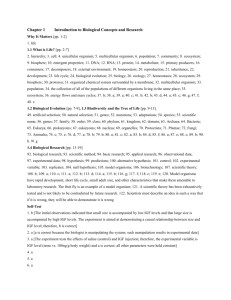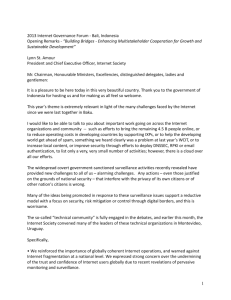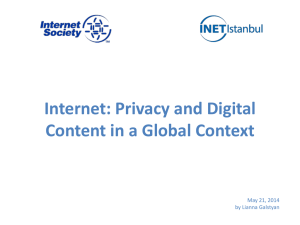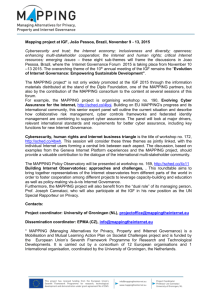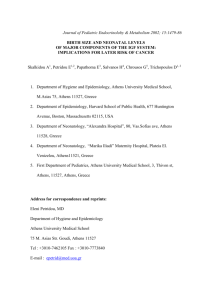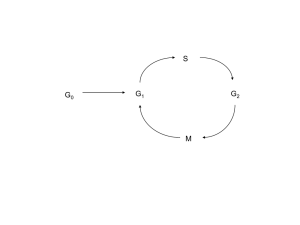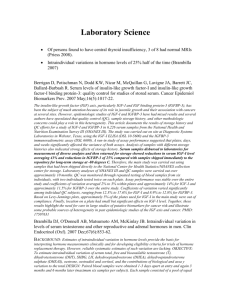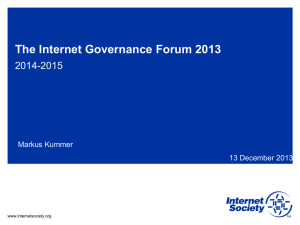The Effect of Insulin-Like Growth Factor Analogs on Turkey Satellite
advertisement
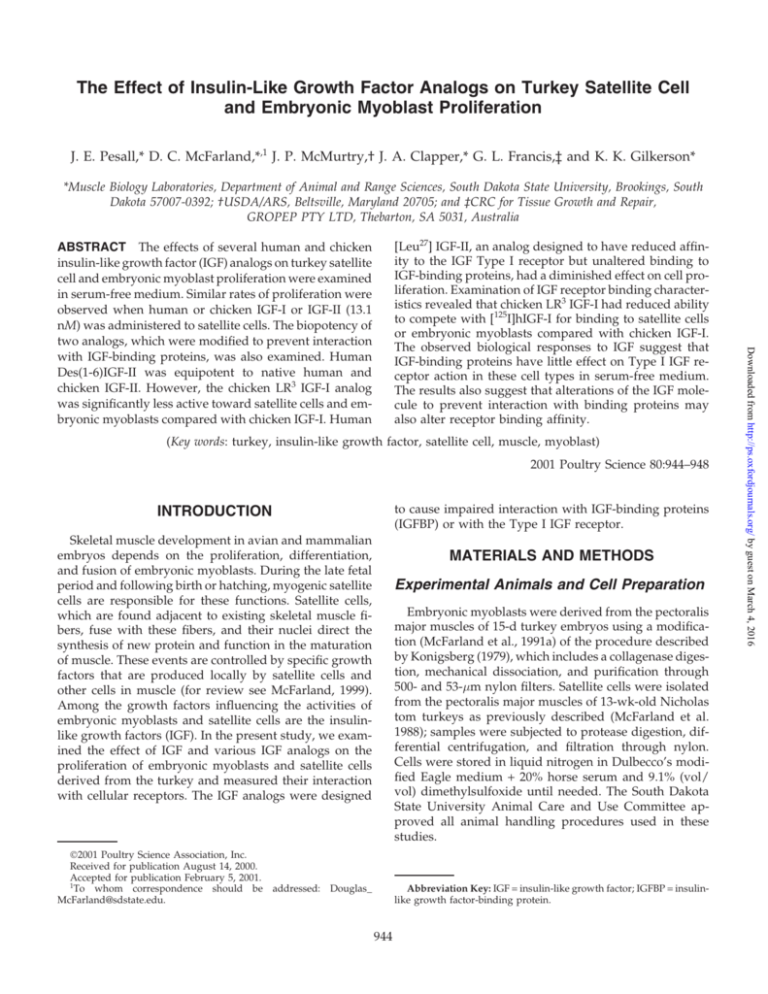
The Effect of Insulin-Like Growth Factor Analogs on Turkey Satellite Cell and Embryonic Myoblast Proliferation J. E. Pesall,* D. C. McFarland,*,1 J. P. McMurtry,† J. A. Clapper,* G. L. Francis,‡ and K. K. Gilkerson* *Muscle Biology Laboratories, Department of Animal and Range Sciences, South Dakota State University, Brookings, South Dakota 57007-0392; †USDA/ARS, Beltsville, Maryland 20705; and ‡CRC for Tissue Growth and Repair, GROPEP PTY LTD, Thebarton, SA 5031, Australia (Key words: turkey, insulin-like growth factor, satellite cell, muscle, myoblast) 2001 Poultry Science 80:944–948 to cause impaired interaction with IGF-binding proteins (IGFBP) or with the Type I IGF receptor. INTRODUCTION Skeletal muscle development in avian and mammalian embryos depends on the proliferation, differentiation, and fusion of embryonic myoblasts. During the late fetal period and following birth or hatching, myogenic satellite cells are responsible for these functions. Satellite cells, which are found adjacent to existing skeletal muscle fibers, fuse with these fibers, and their nuclei direct the synthesis of new protein and function in the maturation of muscle. These events are controlled by specific growth factors that are produced locally by satellite cells and other cells in muscle (for review see McFarland, 1999). Among the growth factors influencing the activities of embryonic myoblasts and satellite cells are the insulinlike growth factors (IGF). In the present study, we examined the effect of IGF and various IGF analogs on the proliferation of embryonic myoblasts and satellite cells derived from the turkey and measured their interaction with cellular receptors. The IGF analogs were designed MATERIALS AND METHODS Experimental Animals and Cell Preparation Embryonic myoblasts were derived from the pectoralis major muscles of 15-d turkey embryos using a modification (McFarland et al., 1991a) of the procedure described by Konigsberg (1979), which includes a collagenase digestion, mechanical dissociation, and purification through 500- and 53-µm nylon filters. Satellite cells were isolated from the pectoralis major muscles of 13-wk-old Nicholas tom turkeys as previously described (McFarland et al. 1988); samples were subjected to protease digestion, differential centrifugation, and filtration through nylon. Cells were stored in liquid nitrogen in Dulbecco’s modified Eagle medium + 20% horse serum and 9.1% (vol/ vol) dimethylsulfoxide until needed. The South Dakota State University Animal Care and Use Committee approved all animal handling procedures used in these studies. 2001 Poultry Science Association, Inc. Received for publication August 14, 2000. Accepted for publication February 5, 2001. 1 To whom correspondence should be addressed: Douglas_ McFarland@sdstate.edu. Abbreviation Key: IGF = insulin-like growth factor; IGFBP = insulinlike growth factor-binding protein. 944 Downloaded from http://ps.oxfordjournals.org/ by guest on March 4, 2016 [Leu27] IGF-II, an analog designed to have reduced affinity to the IGF Type I receptor but unaltered binding to IGF-binding proteins, had a diminished effect on cell proliferation. Examination of IGF receptor binding characteristics revealed that chicken LR3 IGF-I had reduced ability to compete with [125I]hIGF-I for binding to satellite cells or embryonic myoblasts compared with chicken IGF-I. The observed biological responses to IGF suggest that IGF-binding proteins have little effect on Type I IGF receptor action in these cell types in serum-free medium. The results also suggest that alterations of the IGF molecule to prevent interaction with binding proteins may also alter receptor binding affinity. ABSTRACT The effects of several human and chicken insulin-like growth factor (IGF) analogs on turkey satellite cell and embryonic myoblast proliferation were examined in serum-free medium. Similar rates of proliferation were observed when human or chicken IGF-I or IGF-II (13.1 nM) was administered to satellite cells. The biopotency of two analogs, which were modified to prevent interaction with IGF-binding proteins, was also examined. Human Des(1-6)IGF-II was equipotent to native human and chicken IGF-II. However, the chicken LR3 IGF-I analog was significantly less active toward satellite cells and embryonic myoblasts compared with chicken IGF-I. Human INSULIN-LIKE GROWTH FACTOR ANALOGS 945 Materials Media, sera, and antibiotics were purchased from Life Technologies.2 Cell culture ware was obtained from Corning Glass Works.3 Basic fibroblast growth factor, hIGF-I and hIGF-II were purchased from Peprotech.4 Recombinant chicken IGF (cIGF)-I and cIGF-II were obtained from GroPep.5 Chicken insulin was provided by the USDA National Pituitary Hormone Program.3 Chicken LR3 IGFI was a gift from Z. Upton.6 Hoechst 33258 fluorochrome, double-stranded calf thymus DNA standard and [125I]IGF-I were purchased from Amersham Pharmacia Biotech.7 All other reagents were purchased from Sigma Chemical Company.8 Cell Culture and Receptor Assays 2 Life Technologies, Rockville, MD 20849-6482. Corning Glass Works, Corning, NY 14830. Peprotech, Rocky Hill, NJ 08553-0275. 5 GroPrep, Thebarton, SA 5031, Australia. 6 CRC for Tissue Growth and Repair, Thebarton, SA 5031, Australia. 7 Amersham Pharmacia Biotech, Piscataway, NJ 08855-1327. 8 Sigma Chemical Company, St. Louis, MO 63178-9916. 3 4 FIGURE 1. The effect of insulin-like growth factors (IGF), IGF analogs, or insulin (13.1 nM) on proliferation of turkey (a) embryonic myoblasts or (b) satellite cells in a serum-free medium (McFarland et al., 1991b). Proliferation levels were assessed by measurement of the DNA content of cell culture wells as described in Materials and Methods. Each data point represents the mean ± SE of five well observations. Bars not sharing common letters differ statistically (P ≤ 0.05). RESULTS AND DISCUSSION Research in recent years on the relative potency of IGF analogs in comparison to native or recombinant IGF has indicated that the analogs that have a reduced affinity for IGFBP are often more potent stimulators of growth and protein synthesis in vivo and in vitro (Ross et al., 1989; Francis et al., 1993; Tomas et al., 1993; Hill et al., 1999). The objective of this study was to compare the effects of human and chicken IGF and IGF analogs on turkey embryonic myoblast and satellite cell proliferation. To evaluate the mitogenic effects of IGF and analogs, we conducted all proliferation studies in serum-free medium to eliminate complications arising from the interference of IGFBP and mitogens found in serum. Figure 1 illustrates the relative potencies of the various peptides in promoting turkey embryonic myoblast (a) and satellite cell (b) proliferation. In this figure, the effects of all IGF were compared at 13.1 nM because our previous studies with turkey satellite cells indicated that higher concentrations of IGF did not yield any increase in growth (McFarland, 1992). At this concentration, human and chicken IGF-I and IGF-II induce similar rates of proliferation in Downloaded from http://ps.oxfordjournals.org/ by guest on March 4, 2016 Cells were plated on Dulbecco’s modified Eagle Medium + 10% horse serum in gelatin-coated, 16 mm diameter wells (24-well plates) at 15,000 cells per well and were allowed to attach for 24 h. After attachment, the cells were administered treatments of IGF or analogs. Treatments were applied to five well replicates daily for 2 d (embryonic myoblasts) or 3 d (satellite cells) in serumfree medium. The composition of the serum-free medium was as described (McFarland et al., 1991b) except that basic fibroblast growth factor was included at 20 ng/ mL, insulin at 5 ng/mL, and vitamin A at 1 IU/mL. In addition, Deutsch fetuin and dexamethasone were eliminated from the original formulation. Proliferation rates were determined by measuring the DNA content in the wells using a fluorescence technique previously described (McFarland et al. 1995). Briefly, wells were rinsed with PBS, frozen at −90 C, trypsinized, refrozen, and thawed before the addition of TNE/ Hoechst assay buffer [10 mM Tris + 2 M NaCl + 1 mM EDTA+ (100 or 200 ng/mL Hoechst 33258), pH 7.4] to each well. The solutions in the wells were transferred to cuvettes, and the fluorescence was measured in a Hoefer TKO-100 fluorometer (excitation at 365 nm, emission at 460 nm).7 Measurement of the interaction of cIGF-I and chicken LR3 IGF-I analog with embryonic myoblast and satellite cell IGF receptors was determined with competitive binding assays on near-confluent cultures with human [125I] IGF-I in 35 mm diameter wells as previously described (Minshall et al., 1990; Sun et al., 1992). Statistical analyses of proliferation rates were performed using the Duncan’s new multiple-range test with SAS software (SAS, 1989). Statistical analyses of the receptor data from Scatchard analyses were as previously described (Yun et al., 1997). 946 PESALL ET AL. FIGURE 2. The effect of increasing levels of insulin-like growth factor (IGF), IGF analogs, or insulin on proliferation of turkey satellite cells. Proliferation levels were assessed by measurements of the DNA content of cell culture wells as described in Materials and Methods. Each data point represents the mean ± SE of five cell well observations. ated through the tyrosine kinase signaling of the Type I IGF receptor. Moreover, the role of the Type II IGF receptor, which appears to be absent from avian species (Bassas et al., 1988; Duclos et al., 1991; McFarland et al., 1992; Sun et al. 1992), is not relevant. The mitogenic effects of increasing levels of the IGF and analogs were only determined on turkey satellite cells, because the serum-free medium used was specifically developed for this cell type. At IGF levels lower than 13.1 nM, turkey embryonic myoblasts fused rapidly and detached from the substrata, precluding its use in dose-response measurements. Figure 2 illustrates that human IGF-I and IGF-II did not differ from their chicken counterparts in mitogenic potency at all concentrations tested. Turkey satellite cells were more responsive to human and chicken IGF-I preparations at lower levels compared to human and chicken IGF-II preparations, but all were similar in potency at 13.1 nM. Des(1-6)IGF-II did not exhibit a significant difference in mitogenicity compared to human or chicken IGF-II, even though it has a slightly lower binding affinity for the Type I IGF receptor (Francis et al., 1993). [Leu27] IGF-II, which has low affinity for the Type I IGF receptor (Beukers et al., 1991; Sakano et al., 1991), exhibited low mitogenic potencies, similar to insulin. Chicken LR3 IGF-I appeared to have lower potency than expected from the results with human LR3 IGF-I (Francis et al., 1992). To determine if the observed differences in relative potency of chicken LR3 IGF-I and cIGF-I were due to variations in receptor binding characteristics, competitive binding assays were conducted using [125I] human IGFI. As indicated by the data in Table 1, chicken LR3 IGF-I has reduced ability to compete with the radioligand for binding to the Type I IGF receptor in embryonic myoblasts and satellite cells. In conclusion, our results suggest that the affinity of a particular IGF peptide for the Type I IGF receptor is the determining factor in predicting mitogenic potency with Downloaded from http://ps.oxfordjournals.org/ by guest on March 4, 2016 both cell types. This response was similar to the equipotent effects of human IGF and Des(1-3)IGF-I, observed with protein degradation measurements with chick embryonic fibroblasts (Ross et al., 1989). It is interesting to note that these workers observed a difference in the order of potency of the IGF between other species and cell types, which was believed to be the result of different IGFBP that were secreted. Our results are also in agreement with research showing that cIGF-II and hIGF-II are equipotent to inhibit protein degradation in chick embryonic fibroblasts (Upton et al., 1995). In rat L6 myoblasts, however, chicken IGF-II was less potent in stimulating protein synthesis than human IGF-II (Upton et al., 1995), and chicken IGF-I had similar potency to human IGF-I in stimulating protein synthesis in rat L6 myoblasts (Upton et al., 1992). Two of the IGF analogs studied here, LR3 IGF-I, which corresponds to the human analog LR3 IGF-I (Francis et al., 1992), and human Des(1-6)IGF-II (Francis et al., 1993), have reduced binding to IGFBP. Des(1-6)IGF-II, which has a slightly reduced affinity for the Type I receptor compared to IGF-II (Francis et al., 1993), was equipotent with chicken and human IGF-I and IGF-II in our measurements. In fetal rat hepatocytes, human IGF-II and Des(16)IGF-II both stimulated glycogenesis equally in the absence of IGFBP, but IGF-II stimulation was depressed in the presence of IGFBP (Menuelle et al., 1999). In a protein synthesis assay utilizing L6 myoblasts, human Des(16)IGF-II was slightly more potent than IGF-II but was much less potent than human LR3 IGF-I (Francis et al., 1993). Studies with normal (Tomas et al., 1993) and dexamethasone-treated rats (Tomas et al., 1992) indicated that human LR3 IGF-I was more potent than human IGF-I in promoting growth and reversing the catabolic effects of dexamethasone on body weight and nitrogen retention. LR3 IGF-I infusion has also been shown to help conserve whole-body and skeletal muscle protein in feed-restricted heifers (Hill et al., 1999) and increase growth in neonatal pigs (Walton et al., 1995). In finisher pigs, however, human LR3 IGF-I infusion inhibited growth (Walton et al., 1995; Dunaiski et al., 1997). In our study, chicken LR3 IGF-I, which, like the corresponding human analog, has a much lower affinity for the Type I IGF receptor than IGF-I (Francis et al., 1992), did not inhibit proliferation but was much less mitogenic than any of the chicken and human IGF or the Des(1-6)IGF-II analogs. These results mirror the results observed with chick embryonic fibroblasts, which do not secrete any detectable IGFBP into culture media (Francis et al., 1992). In these cells, human LR3 IGF-I was much less potent than IGF-I or des(1-3)IGFI in stimulating protein synthesis (Francis et al. 1992). The lack of IGFBP may not explain the results observed with the turkey cells, because they do secrete IGFBP into the media (McFarland et al., 1993; Ernst et al., 1996). The [Leu27] IGF-II analog has a greatly reduced affinity for the Type I IGF receptor, but binding to the Type II IGF receptor (Beukers et al., 1991; Sakano et al., 1991) and the IGFBP (Bach et al., 1993) is similar to IGF-II. In our study, [Leu27] IGF-II was the least mitogenic peptide. This result is not surprising, as the anabolic actions of IGF are medi- INSULIN-LIKE GROWTH FACTOR ANALOGS TABLE 1. Interaction of chicken insulin-like growth factor (IGF)-I and chicken LR3 insulin-like growth factor-I analog with embryonic myoblast and satellite cell IGF receptors 50% inhibition constant (pmoles)1 Item Chicken IGF-I Chicken LR3 IGF-I Embryonic myoblasts Satellite Cells 3.84 2.98 5.63* 4.61* 1 Values indicate levels of ligand where competition for binding [125I]IGF-I was inhibited 50%. *Values within a row are different (P ≤ 0.05). ACKNOWLEDGMENTS This project was funded by the South Dakota Agricultural Experiment Station Project NC-131 and the South Dakota Poultry Industries Association. Scientific paper number 3201. REFERENCES Bach, L. A., S. Hsieh, K. Sakano, H. Fujiwara, J. F. Perdue, and M. M. Rechler, 1993. Binding of mutants of human insulinlike growth factor II to insulin-like growth factor binding proteins 1-6. J. Biol. Chem. 268:9246–9254. Bassas, L., M. A. Lesniak, J. Serrano, J. Roth, and F. De Pablo, 1988. Developmental regulation of the insulin and Type I insulin like growth factor receptors and absence of Type II receptors in chicken embryo tissues. Diabetes 37:637–644. Beukers, M., Y. Oh, H. Zhang, N. Ling, and R. G. Rosenfeld, 1991. [Leu27] Insulin-like growth factor II is highly selective for the Type-II IGF receptor in binding, cross-linking and thymidine incorporation experiments. Endocrinology 128:1201–1203. Duclos M. J., R. S. Wilkie, and C. Goddard, 1991. Stimulation of DNA synthesis in chicken muscle satellite cells by insulin and insulin-like growth factors: Evidence for exclusive mediation by a Type-I insulin-like growth factor receptor. J. Endocrinol. 128:35–42. Dunaiski, V., F. R. Dunshea, P. E. Walton, and C. Goddard, 1997. Long [R3] insulin-like growth factor-I reduces growth, plasma growth hormone, IGF binding protein-3 and endogenous IGF-I concentrations in pigs. J. Endocrinol. 155:559–565. Ernst, C. W., D. C. McFarland, and M. E. White, 1996. Expression of insulin-like growth factor II (IGF-II), IGF binding protein2 and myogenin during differentiation of myogenic satellite cells derived from the turkey. Differentiation 61:25–33. Francis, G. L., S. E. Aplin, S. J. Milner, K. A. McNeil, F. J. Ballard, and J. C. Wallace, 1993. Insulin-like growth factor (IGF)-II binding to IGF-binding proteins and IGF receptors is modified by deletion of the N-terminal hexapeptide or substitution of arginine for glutamate-6 in IGF-II. Biochem. J. 293:713–719. Francis, G. L., M. Ross, F. J. Ballard, S. J. Milner, C. Senn, K. A. McNeil, J. C. Wallace, R. King, and J.R.E. Wells, 1992. Novel recombinant fusion protein analogues of insulin-like growth factor (IGF)-I indicate the relative importance of IGF-binding protein and receptor binding for enhanced biological potency. J. Mol. Endocrinol. 8:213–223. Hill, R. A., R. A. Hunter, D. B. Lindsay, and P. C. Owens, 1999. Actions of Long(R3)-insulin-like growth factor-1 on protein metabolism in beef heifers. Dom. Anim. Endocrinol. 16:219–229. Holzenberger, M., F. Lapointe, M. Leibovici, C. A. Lievre, 1996. The avian IGF Type 1 receptor: cDNA analysis and in situ hybridization reveal conserved sequence elements and expression patterns relevant for the development of the nervous system. Devel. Brain Res. 97:76–87. Konigsberg, I. R., 1979. Skeletal myoblasts in culture. Pages 511– 527 in: Methods in Enzymology. Vol. LVIII. W. B. Jakoby, and I. H. Pastan, ed. Academic Press, New York, NY. Lord, A.P.D., S.E.P. Bastian, L. C. Read, P. E. Walton, and F. J. Ballard, 1994. Differences in the association of insulin-like growth factor-I (IGF-I) and IGF-I variants with rat, sheep, pig, human and chicken plasma-binding proteins. J. Endocrinol. 140:475–482. McFarland, D. C., 1992. Cell culture as a tool for the study of poultry skeletal muscle development. J. Nutr. 122:818–829. McFarland, D. C., 1999. Influence of growth factors on poultry myogenic satellite cells. Poultry Sci. 78:747–758. McFarland, D. C., M. E. Doumit, and R. D. Minshall, 1988. The turkey myogenic satellite cell: optimization of in vitro proliferation and differentiation. Tissue Cell 20:899–908. McFarland, D. C., N. H. Ferrin, K. K. Gilkerson, and J. E. Pesall. 1992. Tissue distribution of insulin-like growth factor receptors in the turkey. Comp. Biochem. Physiol. 103B:601–607. McFarland, D. C., J. E. Pesall, and K. K. Gilkerson, 1993. The influence of growth factors on turkey embryonic myoblasts and satellite cells in vitro. Gen. Comp. Endocrinol. 89:415– 424. McFarland, D. C., J. E. Pesall, K. K. Gilkerson, and N. H. Ferrin, 1991a. Comparison of the proliferation and differentiation of myogenic satellite cells and embryonic myoblasts derived from the turkey. Comp. Biochem. Physiol. 100A:439–443. McFarland, D. C., J. E. Pesall, K. K. Gilkerson, W. V. Ye, J. S. Walker, and R. Wellenreiter, 1995. Comparison of in vitro properties of satellite cells derived from the pectoralis major and biceps femoris muscles of growing turkeys. Basic Appl. Myol. 5:27–31. McFarland, D. C., J. E. Pesall, J. M. Norberg, and M. A. Dvoracek. 1991b. Proliferation of the turkey myogenic satellite cell in a serum-free medium. Comp. Biochem. Physiol. 99A:163–167. Menuelle, P., S. Babajko, and C. Plas, 1999. Insulin-like growth factor (IGF) binding proteins modulate the glucocorticoiddependent biological effects of IGF-II in cultured fetal rat hepatocytes. Endocrinol. 140:2232–2240. Minshall, R. D., D. C. McFarland, and M. E. Doumit, 1990. Interaction of insulin-like growth factor I with turkey satellite cells and satellite cell-derived myotubes. Dom. Animal Endocrinol. 7:413–424. Downloaded from http://ps.oxfordjournals.org/ by guest on March 4, 2016 turkey myogenic cells in culture. The low mitogenic potency of [Leu27] IGF-II reconfirms the finding that IGF act only through Type I IGF receptors in avian species. Although turkey satellite cells and embryonic myoblasts produce IGFBP, they do not appear to significantly influence the mitogenic effects of IGF on turkey myogenic cells under our culture conditions. These cells show mitogenic responses to the IGF and analogs that are similar to those observed with chick embryonic fibroblasts, which do not appear to produce IGFBP (Francis et al., 1992). Comparison of the binding of IGF-I and the human LR3 IGF-I and Des(1-3)IGF-I analogs to plasma IGFBP of the chicken and several other species showed marked species differences (Lord et al., 1994). Perhaps these differences along with the small differences in structure between the avian and mammalian Type I IGF receptor (Holzenberger et al., 1996) account for some of the differences we find between species response to the IGF and IGF analogs. Such species variation might explain the observations that the chicken and human IGF seem to be equipotent with chicken and turkey cells but that chicken IGF show different potencies in rat cells. 947 948 PESALL ET AL. Ross, M., G. L. Francis, L. Szabo, J. C. Wallace, and F. J. Ballard, 1989. Insulin-like growth factor (IGF)-binding proteins inhibit the biological activities of IGF-1 and IGF-2 but not des(1-3)-IGF-1. Biochem. J. 258:267–272. Sakano, K., T. Enjoh, F. Numata, H. Fujiwara, Y. Marumoto, N. Higashihashi, Y. Sato, J. Perdue, and Y. Fujita-Yamaguchi, 1991. The design, expression, and characterization of human insulin-like growth factor II (IGF-II) mutants specific for either the IGF-II/cation-independant mannose 6-phosphate receptor or IGF-I receptor. J. Biol. Chem. 266:20626–20635. Statistical Analysis System User’s Guide, 1989. Statistics. SAS Institute Inc., Cary, NC. Sun, S. S., D. C. McFarland, N. H. Ferrin, and K. K. Gilkerson, 1992. Comparison of insulin-like growth factor interaction with satellite cells and embryonic myoblasts derived from the turkey. Comp. Biochem. Physiol. 102A:235–243. Tomas, F. M., S. E. Knowles, C. S. Chandler, G. L. Francis, P. C. Owens, and F. J. Ballard, 1993. Anabolic effects of insulinlike growth factor-I (IGF-I) and an IGF-I variant in normal female rats. J. Endocrinol. 137:413–421. Tomas, F. M., S. E. Knowles, P. C. Owens, C. S. Chandler, G. L. Francis, L. C. Read, and F. J. Ballard, 1992. Insulin-like growth factor-I (IGF-I) and especially IGF-I variants are anabolic in dexamethasone-treated rats. Biochem. J. 282:91–97. Upton, Z., G. L. Francis, K. Kita, J. C. Wallace, and F. J. Ballard, 1995. Production and characterization of recombinant chicken insulin-like growth factor-II from Escherichia coli. J. Mol. Endocrinol. 14:79–90. Upton, F. Z., M. Ross, G. L. Francis, J. C. Wallace, and F. J. Ballard, 1992. Production and characterization of recombinant chicken insulin-like growth factor-I from Escherichia coli. J. Mol. Endocrinol. 9:83–92. Walton, P. E., F. R. Dunshea, and F. J. Ballard, 1995. In vivo actions of IGF analogues with poor affinities for IGFBPs: Metabolic and growth effects in pigs of different ages and GH responsiveness. Prog. Growth Factor Res. 6:385–395. Yun, Y., D. C. McFarland, J. E. Pesall, K. K. Gilkerson, L. S. Vander Wal, and N. H. Ferrin, 1997. Variation in response to growth factor stimuli in satellite cell populations. Comp. Biochem. Physiol. 117A:463–470. Downloaded from http://ps.oxfordjournals.org/ by guest on March 4, 2016
